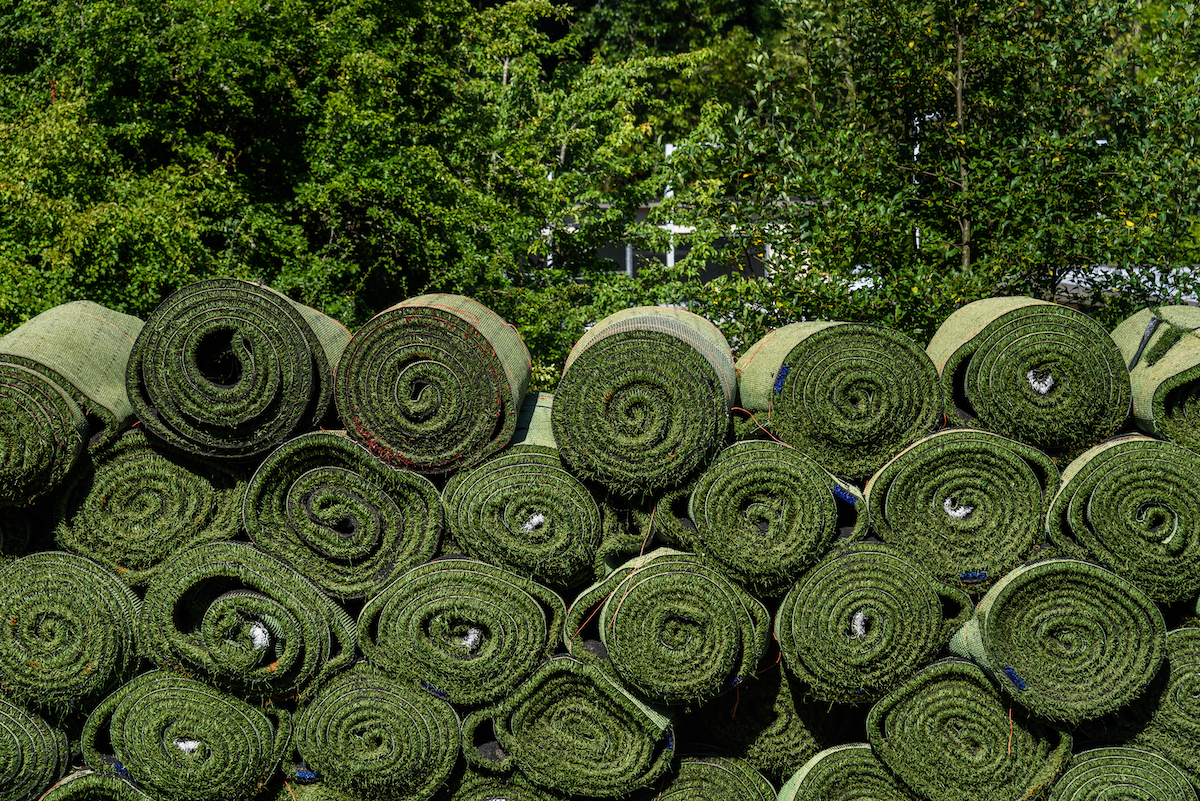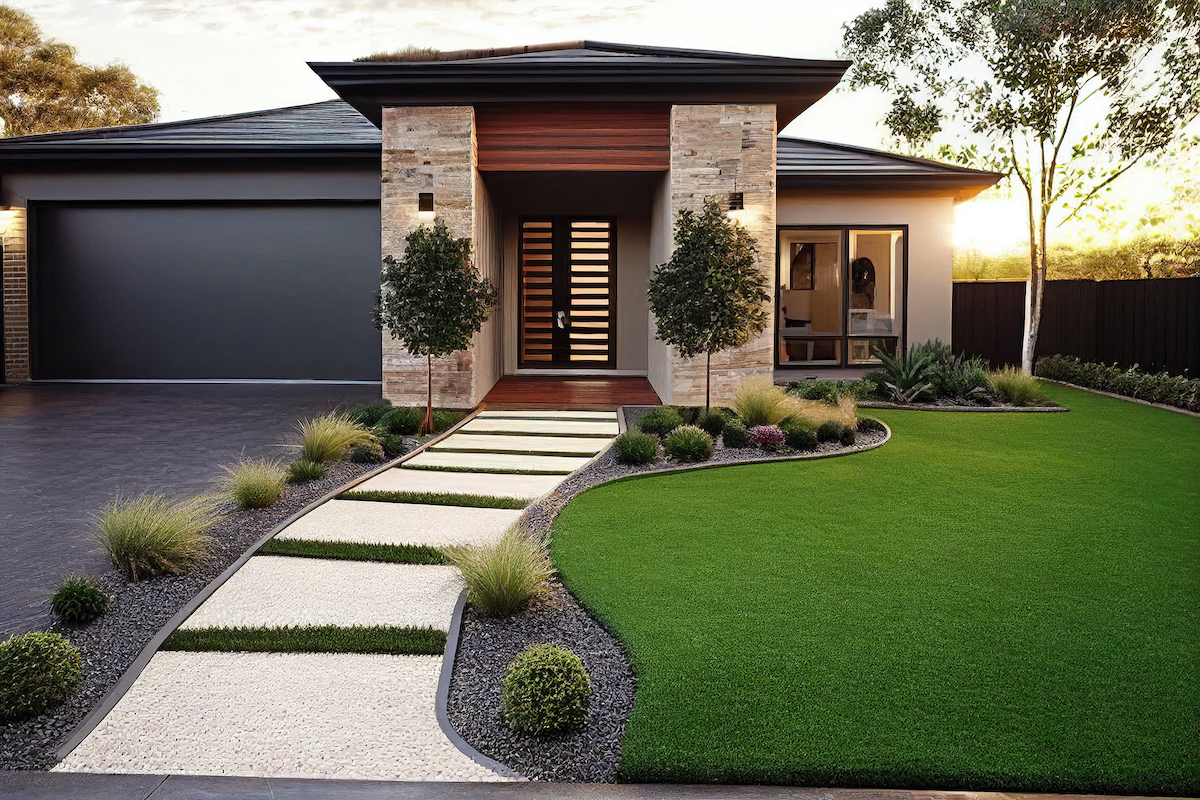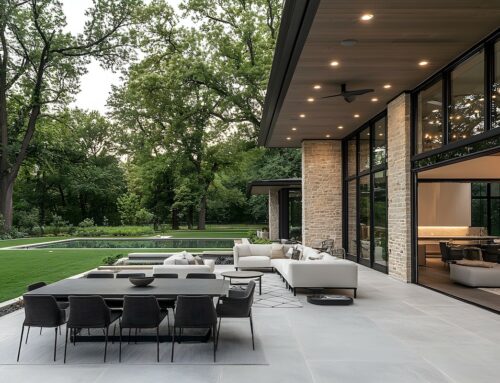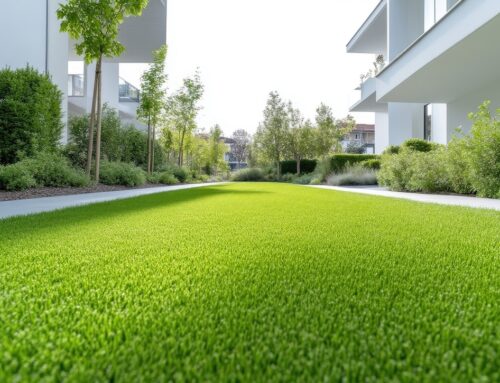Last Updated on February 15, 2024 by ReTurf
Budgeting for a landscaping project is essential for aligning your vision with your financial capabilities. It’s a clear-cut process aimed at defining the financial scope of your endeavor. This initial step is less about the excitement of design choices and more about the practicality of ensuring the financial feasibility of your project. Proper budgeting is key to avoiding overspending and ensuring that every dollar spent contributes directly to the desired outcome of your landscaping work.
The goal of this article is to offer straightforward guidance on preparing a budget for your landscaping project. We’ll explore how to assess your needs against your wants, understand the financial implications of different landscaping components, and make well-informed decisions that balance your aspirations with your budget. This involves a thorough examination of various project elements, such as the type of turf, plants, and hardscape materials, as well as considerations for installation and ongoing maintenance costs.
By focusing on the foundational aspects of budget planning, you can set a solid financial framework for your project. This approach not only helps in managing expenses but also in prioritizing the aspects of your landscape that are most important to you. The emphasis here is on practical decision-making and financial planning to ensure that your landscaping project is both achievable and financially sustainable from the outset.
Assessing Your Landscape Needs: The Foundation of Your Project
Before diving into any landscaping project, taking a step back to evaluate what you’re working with and what you aim to achieve is essential. This process begins with a thorough assessment of your current landscape. Look at your outdoor space as it stands today and consider its size, the condition of any existing turf or plantings, and the overall layout. This initial overview helps identify the baseline from which your project will evolve.
Next, envision what you want your space to become. This isn’t about dreaming up an oasis on a whim but rather defining a clear, achievable outcome that aligns with your lifestyle and preferences. Whether you’re aiming for a low-maintenance yard, a lush garden, or a functional outdoor living area, having a concrete vision is crucial.
Identifying the key elements of your project is where your vision starts to take shape. Consider the types of turf that will best suit your needs, whether it’s durable grass for high-traffic areas or a specific variety that thrives in your climate. Think about the additional features that will enhance your space, such as plantings that add color and texture, hardscapes like paths and patios, or water features that bring a sense of tranquility.
Setting clear goals is the linchpin of effective budgeting. By knowing exactly what you want to achieve, you can prioritize your spending on the elements that matter most. This clarity not only streamlines the budgeting process but also ensures that every decision you make contributes to the realization of your envisioned landscape.

Understanding Turf Options and Costs: Making the Right Choice
When planning your landscape, selecting the right type of turf is a pivotal decision that impacts both the aesthetics and functionality of your outdoor space. The market offers a variety of turf options, each with its own set of benefits, costs, and maintenance requirements. Understanding these differences is key to making an informed decision that aligns with your landscaping goals and budget.
Natural Grass: Traditional and widely preferred for its natural look and feel, natural grass varies in type depending on climate and soil conditions. The initial cost includes soil preparation, seeding or sodding. While the upfront expense might seem manageable, natural grass requires ongoing maintenance such as watering, mowing, and fertilizing, which can add up over time.
Artificial Turf: Offering a low-maintenance alternative to natural grass, artificial turf has gained popularity for its durability and year-round green appearance. The initial installation cost is higher, but savings on water bills, mowing, and other maintenance tasks can offset this over time. Artificial turf is particularly suitable for areas where water conservation is a priority or for high-traffic zones that endure wear and tear.
Specialty Grasses: For those looking for specific qualities, such as drought resistance or the ability to thrive in shady areas, specialty grasses offer tailored solutions. These options might require a higher initial investment due to their unique characteristics and the care needed to establish them successfully.
ReTURF’s Premium Used Turf: A unique option in the turf market is ReTURF’s Premium Quality Used Turf. This lightly used sports field turf comes with special features, such as infill removed, making it an eco-friendly and cost-effective choice. Each roll is meticulously inspected, with small holes and tears patched before shipment. With a weight of 0.75 to 1.25 lbs/sq ft and varying widths, this premium used turf provides a practical solution for larger projects, offering special pricing for orders over 5,000 sq. ft. It’s an appealing option for those seeking quality and durability without the higher costs associated with new artificial turf.
When considering turf for your landscape, weigh the initial installation costs against long-term maintenance expenses. Natural grass may have a lower upfront cost but requires continuous care. Artificial turf, while more expensive initially, can offer savings in the long run. Specialty grasses and premium used options like ReTURF’s provide alternatives that cater to specific needs and preferences.
Choosing the right turf involves balancing your aesthetic desires with practical considerations such as maintenance, durability, and cost. By understanding the pros and cons of each option, you can select a turf that meets your landscape goals and fits your budget, ensuring a beautiful and sustainable outdoor space.

Additional Landscaping Elements: Planning for the Full Picture
Landscaping is more than just turf. It includes a range of elements that enhance the functionality and aesthetics of your outdoor space. When budgeting, it’s crucial to account for these additional features to ensure a comprehensive plan that avoids financial surprises.
Irrigation Systems: Essential for maintaining a healthy landscape, especially in areas prone to dry conditions. The cost can vary widely based on the size of your lawn and the complexity of the system. While a significant upfront investment, an efficient irrigation system can save money in the long term by conserving water and supporting plant health.
Lighting: Outdoor lighting extends the usability of your outdoor space into the evening and enhances security. The costs include not only the fixtures themselves but also the installation and ongoing energy consumption. Solar-powered lights can offer savings on electricity over time.
Patios and Hardscaping: These features create functional outdoor living spaces and pathways. Materials like concrete, stone, and brick can vary significantly in price, impacting the overall budget. Labor costs for installation are also a major consideration.
Plantings: Trees, shrubs, and flowers add life and color to your landscape. Costs depend on the species and size of the plants at the time of purchase. Consider also the long-term maintenance, including watering, pruning, and potential pest control.
DIY vs. Professional Services: Weighing Your Options
DIY Landscaping: Tackling a landscaping project on your own can be a cost-effective way to achieve your desired outcome, especially for simpler tasks like planting or installing small features. The main advantages include saving on labor costs and the satisfaction of personal involvement in improving your space. However, DIY projects require time, physical effort, and a level of expertise to avoid common mistakes that could lead to additional costs or unsatisfactory results.
Hiring Professionals: Professional landscapers bring expertise, efficiency, and access to higher quality materials. While the initial cost is higher compared to DIY, professionals can prevent expensive errors and ensure the project is completed to a high standard. They can also tackle complex projects that might be unfeasible for a DIY approach, such as installing irrigation systems or large-scale hardscaping.
About Us: ReTURF’s Mission
At ReTURF, we’re dedicated to solving a significant challenge in the artificial turf industry: what to do with material at the end of its useful life. For over two decades, we’ve been at the forefront of repurposing used artificial turf, offering an environmentally friendly and cost-effective solution. Our ReTURF Rx3 Facilities lead North America in processing used artificial turf, transforming it for new applications.
Our approach not only reduces landfill waste but also provides communities with affordable options for sports, recreation, and leisure surfaces. Used turf from ReTURF isn’t just a budget-friendly alternative; it’s a product with unique characteristics shaped by its history of use, offering distinct advantages over new turf installations.

Budgeting for Maintenance and Unexpected Expenses
A key aspect of landscaping that often gets overlooked is the ongoing maintenance and the potential for unexpected expenses. Regular maintenance, including watering, mowing, and repairs, is essential to keep your landscaped area looking its best. These activities not only require time but also money, whether it’s for water usage, fuel for lawn mowers, or replacement parts for irrigation systems.
It’s wise to anticipate these ongoing costs and incorporate them into your budget. Additionally, unexpected expenses can arise, such as damage from severe weather or sudden pest infestations. To safeguard against these unforeseen costs, setting aside a portion of your budget is prudent. This contingency fund ensures that your landscape can be promptly and effectively cared for, maintaining its appearance and functionality without causing financial stress. Planning for these expenses means your landscaping project remains a source of enjoyment rather than a financial burden.
Smart Shopping for Landscape Materials
Economizing while shopping for landscape materials can significantly reduce the overall cost of your project. Here are a few strategies to stretch your landscaping budget further:
- Compare Prices: Before making any purchases, compare prices from multiple suppliers. Prices can vary widely for the same products, so shopping around can lead to significant savings.
- Buy in Bulk: For items you need in large quantities, such as mulch, soil, or stone, buying in bulk often results in lower prices per unit. This approach is particularly cost-effective for larger projects or if you’re collaborating with neighbors on similar projects.
- Choose Off-Season Times for Purchases: Prices for plants, trees, and even hardscape materials can fluctuate throughout the year. Buying during off-peak times, such as late fall or early winter, can lead to discounts as retailers clear inventory.
- Look for Deals or Discounts: Keep an eye out for sales, clearance items, or discounts offered by local nurseries and home improvement stores. Signing up for newsletters or loyalty programs can also give you access to exclusive deals.
By adopting these smart shopping practices, you can make the most of your budget, allowing you to achieve your landscaping goals without compromising on quality or scope.

Final Thoughts: Sticking to Your Budget
The cornerstone of a successful landscaping project is adhering to your set budget. It’s easy to get carried away with adding features or upgrading materials, but the discipline to stick to your budget ensures the project stays financially manageable. Regularly review your expenditures to track against your budget, allowing for real-time adjustments. Prioritizing project phases lets you focus on essential elements first, potentially saving additional features for later. If costs begin to creep up, revisit your plans and adjust as necessary to keep within your financial boundaries. Remember, the goal is to achieve a beautiful and functional outdoor space that aligns with your financial comfort, not to stretch your resources too thin.
At ReTURF, we understand the importance of budget-friendly solutions for your landscaping needs. Whether you’re looking for Quality Used Turf with infill removed, Deeply Discounted New Remnant Turf in various colors and sizes and even Game Marked Turf, or High-Quality Used Artificial Turf in Basic and Premium grades, we’ve got you covered. Our Brand New Landscape & Sports Turf from Tempo Turf caters to eco-conscious customers seeking new, innovative solutions. We are committed to providing affordable artificial turf options that don’t compromise on quality, delivered directly to you. For the best deals and custom sizes, reaching out to us can lead to significant savings and ensure your project aligns with your budget and sustainability goals.



